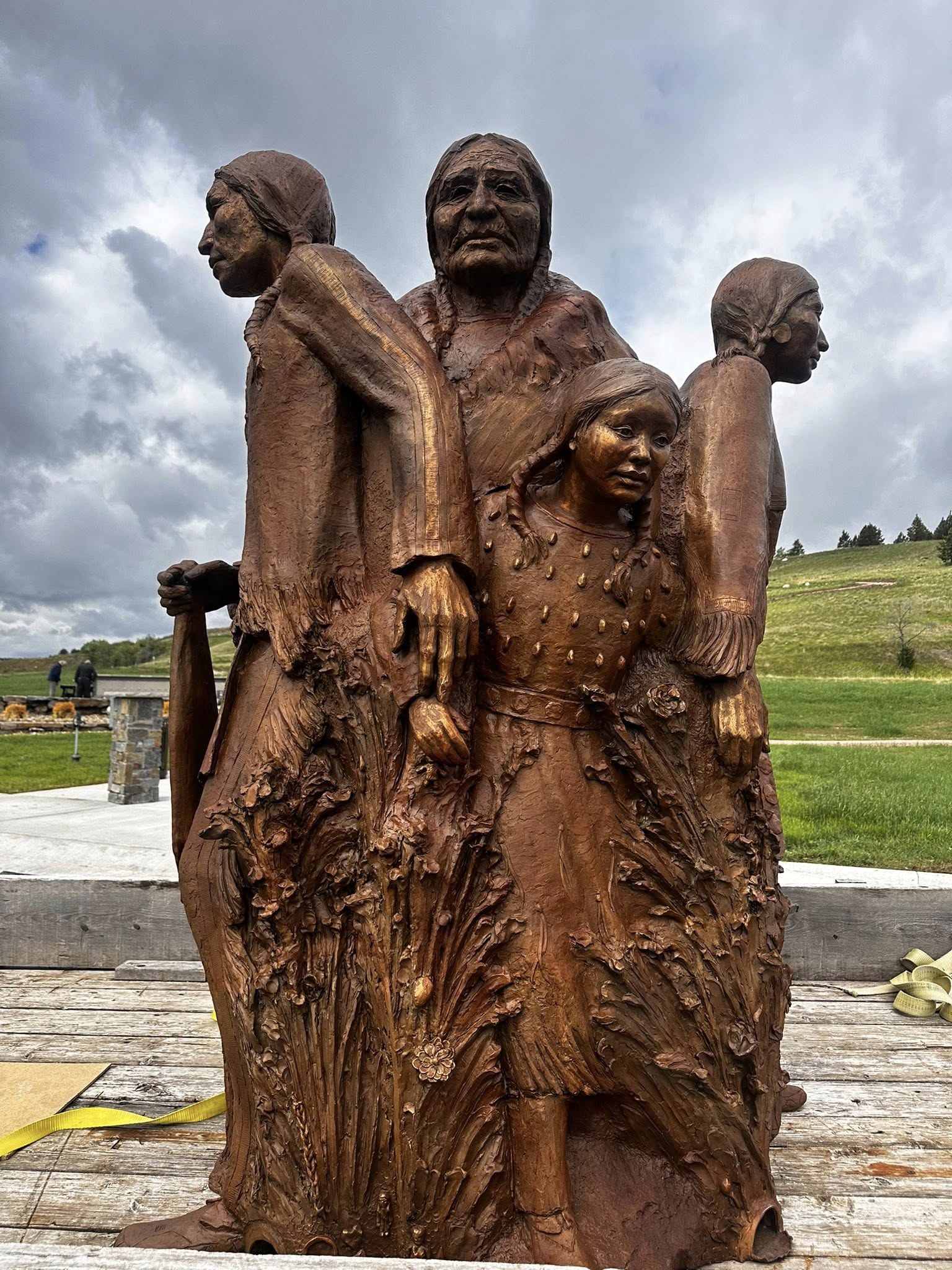
- Details
- By Levi Rickert
On Saturday, May 31, 2035, Rapid City, South Dakota, unveiled a powerful new memorial dedicated to the children who suffered and died at the Rapid City Indian Boarding School. The memorial, named Tiwahe—meaning "family" in Lakota—features a seven-foot-tall bronze sculpture depicting a Lakota family surrounding a young boy dressed in a boarding school uniform. This poignant artwork honors the legacy of over 50 children who perished at the school between 1898 and 1933, many of whom are buried in unmarked graves on the site.
The Rapid City Indian Boarding School operated from 1898 to 1933, aiming to assimilate Native American children by removing them from their families and cultures. The Tiwahe sculpture was created in collaboration with local artist Dale Lamphere and Indigenous artists, with mentorship provided by Lamphere. The sculpture's unveiling marks a significant milestone in the ongoing efforts to honor the memories of these children and acknowledge the painful history of the boarding school era.
The memorial is part of a broader initiative led by the organization Remembering the Children, founded by Amy Sazue, an Oglala/Sicangu Lakota activist. The organization has worked for over a decade to raise awareness about the children who died at the Rapid City Indian Boarding School and to establish a memorial that honors their lives.
“That Indian people have endured quietly. Just like the people in the statue when you look at their faces," Sazue said. "I hope it builds understanding. I hope it builds some empathy. That it brings people to a place of trying to understand people unlike them from parts of the community they’re not aware of or don’t know of and bring us together.”
The sculpture is clay cast in bronze. It’s a collaboration between South Dakota Artist Laureate Dale Lamphere, the organization, spiritual leaders, elders and area children. About 100 different people contributed input and helped sculpt the piece.
The memorial site is located on a 25-acre plot of land that includes the unmarked graves of these children. Plans for the site include a walking path with boulders displaying the names of the children, ceremonial scaffolds, and sweat lodges, all designed to provide a space for reflection, healing, and cultural practices.
The unveiling of the Tiwahe sculpture is a significant step in the healing process for the Native American community in Rapid City and beyond. It serves as a reminder of the resilience and strength of Native American families and communities in the face of historical trauma. The memorial not only honors the children who died at the boarding school but also educates the public about this dark chapter in American history, fostering understanding and reconciliation.
As the memorial continues to develop, it stands as a testament to the power of remembrance and the importance of acknowledging past injustices to pave the way for a more inclusive and compassionate future.
More Stories Like This
Native News Weekly (August 25, 2024): D.C. BriefsUS Presidents in Their Own Words Concerning American Indians
Indigenous Actor Elaine Miles Reports Detention by Alleged ICE Agents
Happy Thanksgiving from Native News Online
Coming Up on Native Bidaské: Behind the Animation: Joey Clift Talks “Pow” and Native Storytelling
Help us tell the stories that could save Native languages and food traditions
At a critical moment for Indian Country, Native News Online is embarking on our most ambitious reporting project yet: "Cultivating Culture," a three-year investigation into two forces shaping Native community survival—food sovereignty and language revitalization.
The devastating impact of COVID-19 accelerated the loss of Native elders and with them, irreplaceable cultural knowledge. Yet across tribal communities, innovative leaders are fighting back, reclaiming traditional food systems and breathing new life into Native languages. These aren't just cultural preservation efforts—they're powerful pathways to community health, healing, and resilience.
Our dedicated reporting team will spend three years documenting these stories through on-the-ground reporting in 18 tribal communities, producing over 200 in-depth stories, 18 podcast episodes, and multimedia content that amplifies Indigenous voices. We'll show policymakers, funders, and allies how cultural restoration directly impacts physical and mental wellness while celebrating successful models of sovereignty and self-determination.
This isn't corporate media parachuting into Indian Country for a quick story. This is sustained, relationship-based journalism by Native reporters who understand these communities. It's "Warrior Journalism"—fearless reporting that serves the 5.5 million readers who depend on us for news that mainstream media often ignores.
We need your help right now. While we've secured partial funding, we're still $450,000 short of our three-year budget. Our immediate goal is $25,000 this month to keep this critical work moving forward—funding reporter salaries, travel to remote communities, photography, and the deep reporting these stories deserve.
Every dollar directly supports Indigenous journalists telling Indigenous stories. Whether it's $5 or $50, your contribution ensures these vital narratives of resilience, innovation, and hope don't disappear into silence.
 The stakes couldn't be higher. Native languages are being lost at an alarming rate. Food insecurity plagues many tribal communities. But solutions are emerging, and these stories need to be told.
The stakes couldn't be higher. Native languages are being lost at an alarming rate. Food insecurity plagues many tribal communities. But solutions are emerging, and these stories need to be told.
Support independent Native journalism. Fund the stories that matter.
Levi Rickert (Potawatomi), Editor & Publisher

